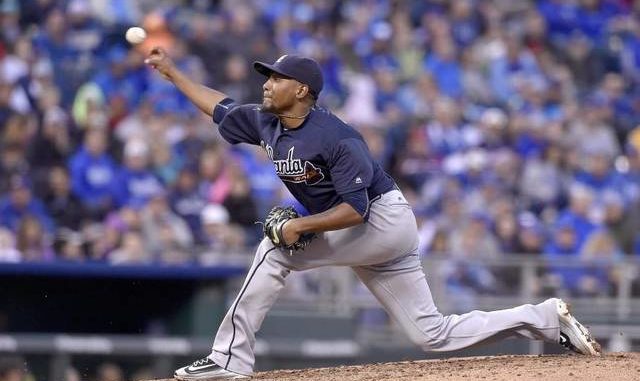
Moving on from the position players, we go to the area of the most tremendous depth of any team in the league, the Braves pitching organizational depth. Starting pitching should be a strength up and down the organization. As with the position players I will be indicating the five starters I anticipate seeing at the start of the season by level, but the back-ups will be the long relievers and spot starters that could play their way into expanded roles.
Part 1 will look at the rotations for Atlanta and AAA Gwinnett. Part 2 will cover AA Mississippi and the high-A Florida Fire Frogs. Part 3 will cover the low-A Rome Braves and rookie league Danville Braves.
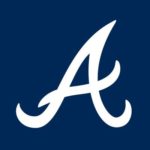 ATLANTA BRAVES
ATLANTA BRAVES
STARTER: Julio Teheran
After an off-season where the Braves very publicly pursued trades for a so-called “true ace”, Teheran looks to once again be in line for an Opening Day start. Teheran comes in to his age 26 season with four consecutive campaigns of at least 180 innings pitched, a team-friendly contract that could keep him in Atlanta through 2021, and coming off arguably his most effective season. Teheran reduced his walks to 2.0 per 9 innings while ticking up his strikeout rate. The main improvement was Teheran’s work against left-handed hitters, which emerged as a serious concern as lefty hitters posted a .893 OPS against him in 2015. That dropped nearly 150 points in 2016. The main reason for this seams to be that Teheran was getting better height on his release point in 2016; this had the effect of having his primary weapons against lefties, his four-seam fastball and his change-up, getting more sinking action as it moves through the strikezone.
STARTER: Bartolo Colon
Colon is coming off three solid seasons for the New York Mets in which he ate over or near 200 innings every season. He saved the best season for last, as he posted a 3.43 ERA and earned his fourth All-Star selection despite playing as the oldest player in major league ball. Now going into his age 44 season, the man they call “Big Sexy” is 11 wins away from breaking Juan Marichel’s major league record for pitchers born in the Dominican Republic. Colon throws almost exclusively fastballs at this point, and those fastballs aren’t really that fast anymore. What he does is put them exactly where he wants them, almost all of the time, and with movement and deception. Colon’s presence reportedly made a strong impact on how the young Mets starting pitchers approached pitching, and no doubt the Braves are hoping that Colon will impart similar wisdom the team’s stable of talented hurlers.
STARTER: Jaime Garcia
Garcia was acquired from the St. Louis Cardinals for prospects John Gant, Chris Ellis, and Luke Dykstra and is coming off a season in which he pitched 171.2 innings, his highest total since 2011. In between those two seasons, the 30-year-old Garcia has been slowed by labrum and rotator cuff issues which required surgery and thoracic outlet surgery. Garcia also had Tommy John surgery as a minor leaguer. When Garcia is right health-wise, he is an extreme groundball pitcher of the like Atlanta hasn’t had on the mound since Tim Hudson left. Both his two-seam and four-seam pitches dip and dive, as well as his above-average changeup and slider. A completely healthy Garcia could be a tremendous weapon in the middle of the Braves rotation, and he could be the first left-handed starter to pitch significant innings since Mike Minor’s tenure. Working off the final season of a five-year extension he signed with the Cardinals, Garcia has plenty of incentive to make this season a good one, and he could also represent the best potential in-season trading chip for the Braves.
STARTER: Mike Foltynewicz
Coming off the end of 2015 when he he had to have emergency rib resection surgery to deal with life-threatening blood clots, that Foltynewicz was able to come back and pitch in the majors by May is a tremendous success in and of itself. Not able to throw at all in the offseason while recuperating and delayed in spring training due to being on perscribed blood thinners, “Folty” still nearly won a rotation spot out of spring training. Wiser heads prevailed and he worked in Gwinnett to rebuild strength. When he returned he continued to in turns raise hope that his tremendous potential would be realized and sew trepidation that he wouldn’t develop into the top-end starter may envisioned for him as a former first-round pick for the Astros. Despite the late start and missing some mid-season time with bone spurs, Folty pitched a career high 123.1 major league innings and saw across-the-board improvements to his strikeout, walk, and home run rates.
Folty’s bread-and-butter pitch is a four-seam fastball that he can crank to near 100 mph when he has a notion, and it has natural rising action. Folty also has a two-seam sinker that is a potent weapon when he’s able play it off the four-seam, but he tends to overthrow on occasion. He also has a change-up, curve, and slider that he picks and chooses from depending on what’s working for him on a given night. Despite some maddening inconsistency, there’s a lot to hope on with Folty still going into his age 25 season, and with a regular offseason of rest and throwing the Braves will be hopeful that 2017 is the season it comes together for the talented righty.
STARTER: R.A. Dickey
For the first time in six seasons, Dickey didn’t pitch at least 200 innings. It wasn’t injuries that were the problem though, it was performance. With the Blue Jays in the thick of a playoff run, Dickey’s 4.46 ERA and .258/.327/.461 batting line against wasn’t good enough to keep the Jays from trading for Francisco Liriano from the Pirates who ultimately ended up taking Dickey’s rotation spot. Now going into his age 42 season, Dickey and the Braves will hope that a move outdoors will help the movement on his knuckleball. Dickey is known as a fierce competitor and a true professional, working on a lot of the little things like holding runners and fielding his position to help him have an edge. As with Colon, the Braves are hoping that some of this mentality will rub off on the younger pitchers in camp.
BACK-UP: Josh Collmenter
A former Diamondbacks mainstay, Collmenter lost the faith of his club after starting the season with some shoulder tightness, then being mostly ineffective out of the bullpen, through to be fair he wasn’t that less effective than most other Diamondback relievers in 2016. Arizona released him in June and he was picked up by the Cubs on a minor league deal. Collmenter pitched well in four outings for AAA Iowa and was then sold the the Braves, who was looking everywhere for rotation help. Collmenter was the franchise-record 16th starting pitcher used by Atlanta in 2016, and he put up 3 solid starts for the Braves down the stretch, pitching 19 innings to a 2.37 ERA. The Braves rewarded Collmenter this off-season with a $1.2 million major league deal. Collmenter has an extreme overhand pitching motion that he developed throwing tomahawks as a boy, so it makes some sort of karmic sense that he’d end up with the Braves. Collmenter primarily throws a cut fastball that sits in the mid 80s that when he’s doing well he can spot anywhere in or around the zone. His change-up is his primary out pitch and it comes in around 10 mph slower than the cutter. He also has a curveball that he primarily uses as his change-of-pace offering. Collmenter will likely start in the Atlanta bullpen unless injury puts him back in the rotation.
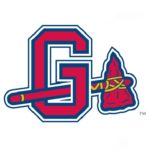 GWINNETT BRAVES (CLASS AAA)
GWINNETT BRAVES (CLASS AAA)
STARTER: Matt Wisler
Wisler came into the 2016 season riding some momentum after six consecutive quality starts to finish out 2015 and reportedly working with Braves great Tom Glavine on improving his change-up. For awhile it looked like Wisler would take that step and he pitched to a 3.16 ERA through the end of May. The wheels really came off in a disaster start on June 5 against the Dodgers though, and Wisler struggled until the Braves demoted him to Gwinnett for four starts in August. The team brought him back up because of injuries and poor performance of other starters and he limped into the offseason with his future with the team in doubt.
Wisler throws a four-seam and a two-seam fastball, but practically the two don’t show much difference in location or velocity. Wisler does have a fantastic slider that gets plenty of swing-and-miss, but hitters have started to lay off of it, looking for the fastball. Wisler’s change-up isn’t consistent enough to keep hitters honest either. Wisler also had issues repeating his release point as the season progressed, and that was something Wisler reportedly was working on in Gwinnett. If Wisler can make strides to either improve his change-up, get more movement on his two-seamer, or have a more consistent release point (or better yet, all three), he could end up being that mid-rotation workhorse the Braves anticipated when they acquired him from San Diego in the Craig Kimbrel trade.
STARTER: Aaron Blair
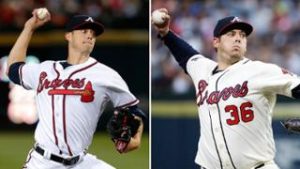
Acquired by the Braves along with Dansby Swanson and Ender Inciarte for Shelby Miller, Blair was advertised as a ready-for-the-majors prospect that had already shown he could beat AAA hitters. This certainly seemed to bear out after his first three starts for Gwinnett in April where he pitched to a 1.42 ERA and no-hit the Durham Bulls for 7 innings. After that start, Blair got The Call. It started well, with quality starts against the Mets, Cubs, and Diamondbacks, but each start was progressively worse until he blew up in a 9-run, 1.1 inning start against the Pirates. Blair was demoted the next day and he rode the Gwinnett-Atlanta shuttle the rest of the season.
Over the course of the year, the Braves and Blair tried many different tweaks to help him get back to expected level. Blair simplified his wind-up and raised his release-point, allowing him to get on top of his sinker more. In August, Blair started throwing a slider for the first time as well, nearly abandoning his curveball. The changes seemed to come together for Blair in his last start of the season as he struck out 10 Detroit Tigers in his last start of the season. If Blair can further refine his mechanics this offseason, he could rebound strongly in AAA.
** TOP 30 PROSPECT** STARTER: Sean Newcomb (Promotion)
The prize prospect of the Andrelton Simmons trade with the Los Angeles Angels, Newcomb spent 2016 with AA Mississippi and lead the Southern League in strikeouts and held opposing batters to a .224 batting average and a .624 OPS. That’s the good news. The bad news is that his walks/9 innings was 4.6. The other good news is that ongoing tweaking of his pitch selection and mechanics lead to a string of splendid starts down the stretch; he pitched to a 2.17 ERA/2.84 FIP in August and September, including two playoff starts. The bad news is that there continues to be whispers of focus issues that lead to some blow-up innings. Newcomb has all the tools to be a front-of-the-rotation starter in the big leagues, and it’s time for him to put together a strong, consistent season to prove it.
**TOP 30 PROSPECT** STARTER: Lucas Sims (Promotion)
Sims enters his sixth minor league season in the Braves organization after being a first round pick in 2012 and steadily making his way up the organizational ladder. Sims has had his share of fits and starts, and 2016 was no different. After dominating the Southern League for three starts, Sims was promoted to AAA Gwinnett in late April and it looked like a major league debut at the age of 22 would be a possibility. Unfortunately, the wheels came off mechanically at Gwinnett and Sims was returned to Mississippi and the care of pitching coach Dennis Llewellyn after compiling a 7.56 ERA/6.31 FIP with the G-Braves. and he slowly came back around, though his walk rate was still fairly high. Sims is doing well at minimizing contact, but he has to develop a third pitch to keep hitters from sitting either fastball or curveball, regardless of how good those pitches are. If he cannot, it may be time for the organization to consider moving him to a reliever role, a role in which he would likely excel.
STARTER: John Danks
John Danks was a solid pitcher for the White Sox until a torn shoulder capsule ended his 2013 season and upended his career. With his 5-year contract extension nearly up, the White Sox cut ties with him last year at the end of April. Danks essentially took the rest of the season off to see if he could regain strength. The Braves have signed him to a minor league deal, so they’ll get a no-risk extended look at him this spring. Danks throws essentially every pitch, and at his peak he had decent control and got plenty of ground balls. After his surgery he has really struggled replicating his mechanics. If Danks does not perform well this spring, it’s probably the end of the line at age 32.
BACK-UP: Joel De La Cruz
BACK-UP: Andrew Albers
BACK-UP: Kris Medlen
De La Cruz made 9 starts for the Atlanta Braves in 2016 and you could say that all of the activity by the team this off-season to bring in more rotation arms was to make sure that never happens again. It’s not that De La Cruz doesn’t have worth, as there will always be a need for rubber-armed pitchers who can switch from starting to relieving and back again to fill gaps as needed. It’s just that De La Cruz just isn’t good enough to start for a major league club, even a non-contending one.
Andrew Albers is a minor league veteran who has gotten a taste of the major leagues the last two season with Toronto and Minnesota respectively. Albers has one of the more colorful baseball careers as he’s gone from: growing up in Saskatchewan; pitching for the University of Kentucky; being drafted in the 10th round of the 2008 draft; needing Tommy John surgery after his first five pro games; being released by the Padres; playing in the independent leagues; being signed by the Twins; being named Twins minor league pitcher of the year in 2012; getting called up in 2013 and pitching 60 big league innings; pitching in Korea; coming back to the States in 2015 and signing with Toronto; getting a call-up with the Blue Jays; signing back with the Twins; and making it back to the majors for 17 more innings in 2016. Now he’s with the Braves and looking for a spot somewhere.
Old friend Kris Medlen is also back with the organization after two season with the Kansas City Royals. Like Danks, Medlen will be looking to see if there’s anything left in the tank after a season ruined by shoulder issues. Medlen will not be competing for a spot in either Atlanta or Lawrenceville this spring as he will still getting treatment, but the Braves hope that he could be an option for either starting or relief around mid-season. When healthy, Medlen has a devastating change-up, and even while rehabbing Medlen could help out by being a sort of assistant pitching coach.

FINAL THOUGHTS: The Braves went into the off-season determined to add rotation depth and they’ve done it, adding three veteran starting pitchers in Colon, Garcia, and Dickey while retaining Josh Collmenter. This will force young players like Foltynewicz, Wisler, and Blair to earn their places in the rotation instead of being handed spots due to injury or poor performance. The Braves are also going back to the well with their repeated tactic of trying out a couple veteran starters with something to prove in Danks and Medlen. Finally, the Braves have two stud prospects in Newcomb and Sims with warts that have somewhat diminished their prospect status, but have the ability to flip the switch and claim their own spots in Atlanta, because while the rotation may be full of veterans now, there should be no expectation that it will stay that way because of age, health, or the ever-present specter of John Coppollela getting that trading itch.
OFR TOP 10 STARTING PITCHING PROSPECT RANKINGS (WITH EXPECTED LEVEL):
- Kolby Allard (A+)
- Mike Soroka (A+)
- Sean Newcomb (AAA)
- Touki Toussaint (A+)
- Max Fried (AA)
- Ian Anderson (A)
- Luiz Gohara (A+)
- Patrick Weigel (AA)
- Lucas Sims (AAA)
- Joey Wentz (A)
Other entries in this series:
Catcher
First Base
Second Base
Third Base
Shortstop
Left Field
Centerfield
Right Field
Starting Pitching, Part 2 (Mississippi/Florida)
Starting Pitching, Part 3 (Rome/Danville)

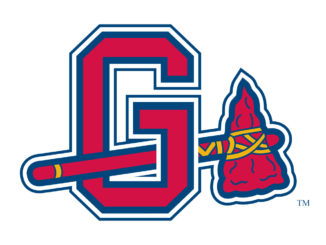
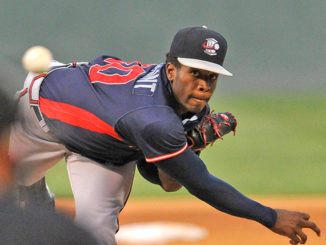
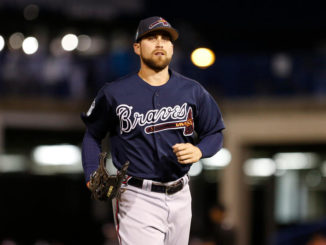
Leave a Reply